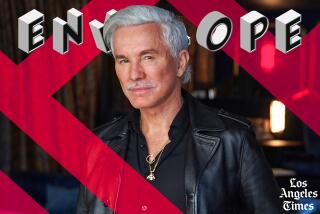Evel Knievel’s hard landings
- Share via
Evel Knievel was a superhero, from the tip of his jumpsuit collar to the bottom of his white boots. He mounted motorcycles, and even a few rocket ships. He leaped cars, buses, rattlesnakes and sharks in a single bound. He wore a cape.
Even so, Knievel was no Superman. Underneath the star-spangled get-up, the first son of Butte, Mont., was a tale-telling, philandering ex-con who once smashed another man’s arms with a baseball bat.
And about those leaps . . . well, they might have entailed a single bound at first, but they usually involved several bone-crushing, skull-fracturing bounces at the end. This superhero was more a crash-test dummy.
This last idea -- that Knievel was basically but a passenger on his daredevil endeavors -- resides at the heart of Stuart Barker’s “Evel Knievel: Life of Evel,” a biography of the self-described “Last Gladiator.” It’s a jarring concept to any child of the 1970s who grew up believing that a man really could fly.
For those unfamiliar with the Knievel story, or hazy on key points in its timeline -- did he blow out at London’s Wembley Stadium before or after sticking the landing at Kings Island? -- Barker’s book seems a solid place to start. Timed to coincide with the one-year anniversary of Knievel’s death at age 69, the biography is a straightforward, start-to-finish tale, moving from his wild-child beginnings to his ravaged end.
Although it could be argued that an innovator such as Knievel deserves more than a standard story line, there’s a certain wisdom in staying out of the way of his story, especially its one-helluva-ride second act. Do we really need more than the facts of Knievel’s Snake River Canyon stunt -- the daredevil’s most famous, and infamous, “jump” -- to convey the beautiful, misplaced courage of a man willing to strap himself into an undertested rocket and press the launch button, essentially leaving it up to a higher power as to whether he spanned the 1,600-foot gap?
The beginning of Knievel’s run was no less touched by madness. In 1965, to promote his struggling Honda bike dealership in Spokane, Wash. -- and with no more relevant experience than some minor motorcycle tricks, an undistinguished career as a dirt-bike racer and childhood memories of a daredevil car show -- Bobby Knievel, as he was then known, ran a 350cc up a wooden ramp, gave the throttle a twist and jumped over two mountain lions and, for good measure and better sales at the gate, a box containing 100 rattlesnakes.
“He was little more than a human cannonball,” Barker writes, “and the crowd knew it.”
The crowd loved it, as well.
Barker understands that Knievel’s crashes were the key to his success. As he notes, the 1975 Kings Island stunt in Ohio -- in which Knievel cleared 14 Greyhound buses, flying a personal-best 133 feet through the air, and scored a clean and, for once, truly happy landing -- isn’t remembered nearly as well as the 1968 Caesars Palace crackup that made him a “Wide World of Sports” star and left him in a coma for 29 days.
The 1974 Snake River fiasco saw his tin can of a rocket-propelled X-2 Sky Cycle pop its parachute on the launch pad, both foiling the stunt and threatening to hurl Knievel into a deadly meeting with the canyon wall. In the 1975 Wembley Stadium disaster, Knievel soared over 13 buses but landed on the wrong tire (the front one) and wound up in a tumbling race with his own bike. (The bike won.)
If Knievel wasn’t in control during these suicide missions, he was in control behind the scenes. Indeed, Barker shows, he was both Elvis Presley and Col. Tom Parker at once. In Knievel’s story, as in Presley’s, the star’s penchant for excess eventually kills the puppet-master’s show.
Elvis ate too much and popped too many pills. Knievel spent too much, forcing him to keep jumping until he scared himself.
Knievel’s demise was more prolonged than Presley’s, but just as ugly; his long slide began with Snake River Canyon and continued unabated after his 1977 assault on promoter-producer Sheldon Saltman. Ideal Toys, which supposedly sold $300 million worth of Knievel action figures in the 1970s, did not want a piece of that Knievel action. Other major endorsements dried up as well.
Barker, a motorcycle writer, writes clearly about the technical end of Knievel’s trade. When trying to put the man into a pop culture context, however, he resorts to cliche. Barker also doesn’t appear to have contributed much new to the Knievel saga, although sorting out the lies from the really big lies, as he does, was likely job enough.
Ultimately, “Evel Knievel: Life of Evel” stands as further proof that, no, Knievel wasn’t a superhero, and that, no, he couldn’t fly.
Not without crashing back to Earth. Really, really, really hard.
More to Read
Sign up for our Book Club newsletter
Get the latest news, events and more from the Los Angeles Times Book Club, and help us get L.A. reading and talking.
You may occasionally receive promotional content from the Los Angeles Times.










